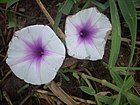Note: This is a project under development. The articles on this wiki are just being initiated and broadly incomplete. You can Help creating new pages.
Difference between revisions of "Ipomoea aquatica"
| Line 1: | Line 1: | ||
[[File:Adat Ombathumuri Paadam Thrissur DSCN0846.JPG|thumb|right]] | [[File:Adat Ombathumuri Paadam Thrissur DSCN0846.JPG|thumb|right]] | ||
| + | |||
'''Ipomoea aquatica''' is a fast-growing, annual or perennial plant with prostrate stems 2 - 3 metres long. The plant roots freely at the nodes and can form large clumps of growth. | '''Ipomoea aquatica''' is a fast-growing, annual or perennial plant with prostrate stems 2 - 3 metres long. The plant roots freely at the nodes and can form large clumps of growth. | ||
==Uses== | ==Uses== | ||
Revision as of 17:35, 5 November 2020
Ipomoea aquatica is a fast-growing, annual or perennial plant with prostrate stems 2 - 3 metres long. The plant roots freely at the nodes and can form large clumps of growth.
Contents
- 1 Uses
- 2 Parts Used
- 3 Chemical Composition
- 4 Common names
- 5 Properties
- 6 Habit
- 7 Identification
- 8 List of Ayurvedic medicine in which the herb is used
- 9 Where to get the saplings
- 10 Mode of Propagation
- 11 How to plant/cultivate
- 12 Commonly seen growing in areas
- 13 Photo Gallery
- 14 References
- 15 External Links
Uses
Coughs, Fever, Sores, Boils, Ringworm, Haemorrhoids.[1]
Parts Used
Chemical Composition
Common names
| Language | Common name |
|---|---|
| Kannada | Chanthion |
| Hindi | Nali |
| Malayalam | |
| Tamil | Sarkaraivalli |
| Telugu | Tutikura |
| Marathi | Nalichi |
| Gujarathi | |
| Punjabi | |
| Kashmiri | |
| Sanskrit | Karemu |
| English | Water Morning Glory |
Properties
Reference: Dravya - Substance, Rasa - Taste, Guna - Qualities, Veerya - Potency, Vipaka - Post-digesion effect, Karma - Pharmacological activity, Prabhava - Therepeutics.
Dravya
Rasa
Guna
Veerya
Vipaka
Karma
Prabhava
Habit
Identification
Leaf
| Kind | Shape | Feature |
|---|---|---|
Flower
| Type | Size | Color and composition | Stamen | More information |
|---|---|---|---|---|
| {{{5}}} |
Fruit
| Type | Size | Mass | Appearance | Seeds | More information |
|---|---|---|---|---|---|
Other features
List of Ayurvedic medicine in which the herb is used
Where to get the saplings
Mode of Propagation
Seeds, Cuttings of young shoots.
How to plant/cultivate
Swamp morning glory is a plant of the moist to wet, lowland tropics, where it is found at elevations up to 1,000 metres. It grows best in areas where annual daytime temperatures are within the range 15 - 35°c, but can tolerate 10 - 40°c.[4]
Commonly seen growing in areas
Inundated localities, Marshy, Shallow pools, Ditches, Rice fields.
Photo Gallery
References
- ↑ Indian Medicinal Plants by C.P.Khare
- ↑ [Chemistry]
- ↑ [Morphology]
- ↑ Cultivation
External Links
- Ayurvedic Herbs known to be helpful to treat Coughs
- Ayurvedic Herbs known to be helpful to treat Fever
- Ayurvedic Herbs known to be helpful to treat Sores
- Ayurvedic Herbs known to be helpful to treat Boils
- Ayurvedic Herbs known to be helpful to treat Ringworm
- Ayurvedic Herbs known to be helpful to treat Haemorrhoids
- Herbs with Leaves used in medicine
- Herbs with Young shoots used in medicine
- Herbs with common name in Kannada
- Herbs with common name in Hindi
- Herbs with common name in Tamil
- Herbs with common name in Telugu
- Herbs with common name in Marathi
- Herbs with common name in Sanskrit
- Herbs with common name in English
- Habit - Perennial
- Index of Plants which can be propagated by Seeds
- Index of Plants which can be propagated by Cuttings of young shoots
- Herbs that are commonly seen in the region of Inundated localities
- Herbs that are commonly seen in the region of Marshy
- Herbs that are commonly seen in the region of Shallow pools
- Herbs that are commonly seen in the region of Ditches
- Herbs that are commonly seen in the region of Rice fields
- Herbs
- Pages without herbs images





